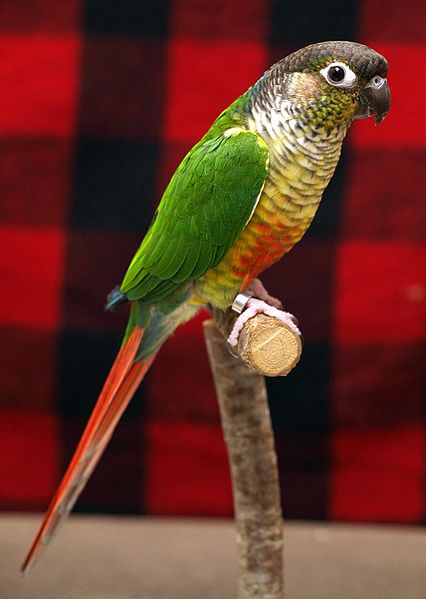Pyrrhura molinae, The Green Cheek Conure, is part of the genus Pyrrhura. One of the smallest of the Conure family, they grow to a maximum of 10 inches including their tails.
The Green Cheek, also known in aviculture as the Green Cheeked Conure, is native to west-central and southern Mato Grosso, Brazil, through northern and eastern Bolivia to northwestern Argentina.

Green Cheek Conures live in large flocks. In the wild, you will find them at the tops of the tree line. While it is on the list of threatened species, it is listed as ‘least concern.’ They are common in captivity and easy to breed. Breeding generally begins after one year of age. A clutch will contain four to six eggs that hatch at 24 weeks. Surgical sexing is recommended to determine gender.
Conures are typically noisy birds however the Green Cheek is considered to be on the quieter side of the breed. They are considered to be intelligent and affectionate. While they’re not considered to be good talkers they can usually learn to speak a few words, though people may have a hard time understanding them due to their typically grave voice. They may also mimic household sounds, whistle, and sing.
They are loyal and social birds and will generally form a strong bond with their families. This bond can be reciprocated and enforced by the owner spending time with them each day.
Affection in the form of petting is usually welcome as is verbal praise. They like to be held and can learn a number of tricks including the important ones like a step up and step down in addition to a few fun tricks.
They are natural chewers and can be quite destructive if not provided with appropriate chew toys. Young Green Cheek Conures can be prone to biting however early socialization and training will generally take care of this tendency. The biting behavior may show up again as they approach sexual maturity. Again, consistent training and attention will help keep this behavior at a minimum.
Young Green Cheeks are often confused with young Maroon Bellied conures. The resemblance has meant they’re often mislabeled in pet stores. They’re both the same size and they’re both primarily green.
However, the Green-Cheek is brighter in color than the Maroon-bellied. The Green Cheek has a gray barring on its chest which fades into a reddish belly. Both Green Cheeks and Maroon Bellies have a dark gray beak and feet.
In the wild Green Cheek Conures eat seeds and fruit and other kinds of vegetable matter. In captivity, they are known to be hearty, and messy eaters, and can often become overweight.
A Green Cheek will live a life expectancy of 25-30 years if they’re fed a pellet-based diet and a daily supply of fresh fruits and vegetables. Regular trips to the avian veterinarian are also key to a long and healthy life.
If a Green Cheek Conure is allowed to spend several hours a day outside of their cage getting the exercise and attention they need, minimum cage requirements are 18″ x 18″ x 24″, with ½” bar spacing.
If, however, owners are not able to spend time with their Green Cheek outside of the cage, it is recommended that a much larger cage be purchased so the bird has space to get the exercise they require.
